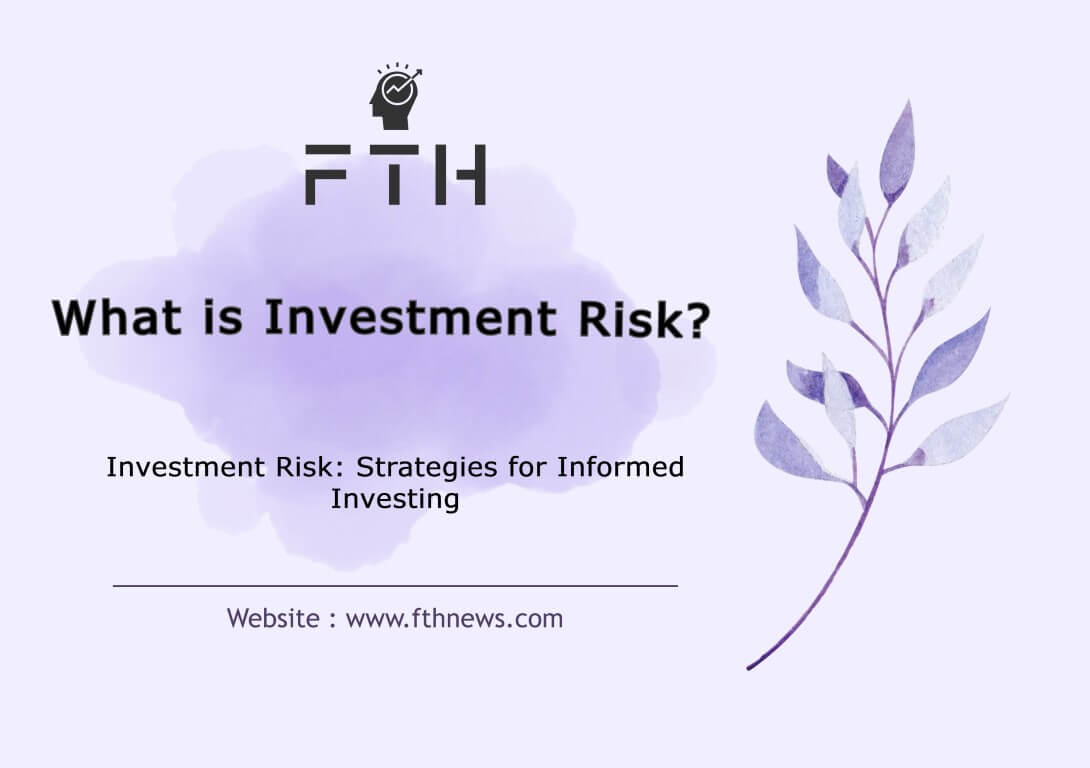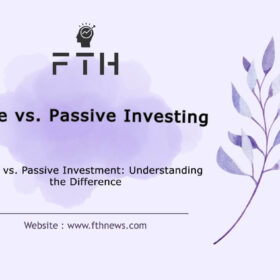
Investment Risk: Strategies for Informed Investing
Investment Risk When we hear the word “risk,” our minds often jump to thoughts of danger and negativity. However, it’s crucial to recognize that risk isn’t solely associated with adverse outcomes; it encompasses the broader concept of uncertainty about the future. In fact, engaging with risk can also lead to positive opportunities, especially when we consider it from a financial perspective. Hence, risk possesses both positive and negative dimensions.
In this article, we aim to delve into the multifaceted world of risk, particularly in the realm of finance and investment. To begin, let’s explore what risk truly means and the various types it can take.
Defining Risk & Investment Risk
Throughout the course of civilization, humanity has consistently confronted a multitude of evolving factors and potential hazards. The specter of harm has perennially loomed, starting with our earliest ancestors who grappled with natural perils. As our species has grown and developed, we’ve encountered a growing array of decisions and complexities, bringing forth an ever-expanding landscape of risks.
Understanding Two Categories of Risk: Pure and Speculative
Risk is a concept that encompasses various aspects of uncertainty, and it often falls into two primary categories:
Pure Risk (Real Risk):
Pure risks are essentially physical perils, such as the risk of accidents, illnesses, divorces, natural disasters, and other unforeseen events. These risks typically lie beyond our control and, when they materialize, result in losses and damages without any potential for gain. Fortunately, pure risks are generally insurable, providing a means to mitigate the financial impact of unfortunate events.
Speculative Risk (Investing Risk):
In contrast to pure risks, speculative risks involve situations where both opportunities for gain and possibilities of loss exist. These risks are commonly associated with investments and business ventures, where individuals knowingly embrace uncertainty in the hope of achieving positive outcomes. Unlike pure risks, speculative risks may lead to either profits or losses, making them distinct from the purely negative nature of pure risks.
Classification of Investors by Risk Acceptance
Investors can be categorized into three distinct groups based on their approach to risk:
Risk-Averse Individuals:
Risk-averse investors adopt a conservative approach. They prioritize safety and reliability, preferring investments that offer a stable and predictable return. These individuals are generally less willing to take on significant risk and prioritize the preservation of their capital. The probability of their investments succeeding is typically higher, but the potential for substantial profits may be limited.
Risk-Taking Individuals:
Risk-taking investors have a bold and adventurous approach. They are willing to accept higher levels of risk in pursuit of potentially greater profits. These individuals are more open to investing in volatile markets or ventures with uncertain outcomes. While the potential for substantial gains is higher, there is also a greater likelihood of incurring losses.
Risk-Neutral Individuals:
The third category consists of risk-neutral investors. These individuals perceive the value of money solely in its nominal form. They do not exhibit a strong preference for either high-risk or low-risk investments. Instead, they base their decisions on objective factors and the potential for returns, without being influenced by risk aversion or risk appetite.
Understanding these distinct investor profiles is essential for making informed investment choices and aligning investment strategies with individual risk tolerance and financial objectives.
Understanding Investment Risk Aversion and Risk-Taking
Risk aversion and risk-taking are not about avoiding or embracing risk entirely but rather reflect how individuals perceive the relationship between risk and reward in their investment decisions.
Risk-Averse Individuals:
Risk-averse investors expect a higher return for each unit of risk they accept compared to a previously accepted level of risk. In essence, they demand more compensation for taking on additional risk. This preference indicates that they prioritize safety and predictability in their investments, and they are less willing to accept higher levels of risk without the prospect of a commensurate reward.
Risk-Taking Individuals:
Conversely, risk-taking investors expect a lower return for each unit of risk they accept compared to a previous level of risk. They are more inclined to accept greater risk in exchange for potentially higher rewards. This perspective acknowledges the fundamental principle that obtaining a higher return often necessitates embracing more risk. In essence, they are willing to spend on risk, recognizing that investments with higher risk potential can yield greater rewards.
Ultimately, the choice between risk aversion and risk-taking depends on an individual’s financial goals, risk tolerance, and investment strategy. Both approaches have their merits and can be applied strategically in different investment scenarios.
Criteria for Measuring Investment Risk
Measuring investment risk is a crucial step in making informed financial decisions. Several criteria are employed to assess the level of risk associated with an investment, with one of the primary indicators being the standard deviation of historical returns or the average return of an investment.
Standard Deviation of Historical Returns:
The standard deviation measures the dispersion of an investment’s historical returns. A high standard deviation indicates greater variability in returns over time, signaling a higher level of investment risk. Investors often use this metric to gauge the potential fluctuations in their investments.
Apart from standard deviation, many companies invest significant time and financial resources to identify and assess various risks they may encounter in their investment portfolios. These risks can typically be categorized into two fundamental types:
Systematic Investment Risk:
Systematic risk is inherent to the broader political and economic conditions of society. It cannot be eliminated and affects the entire market rather than being limited to a specific industry. Common examples include macroeconomic factors like inflation rates, interest rates, and geopolitical events.
Unsystematic Investing Risk:
In contrast to systematic risk, unsystematic risk is specific to individual companies or industries. It can be controlled and mitigated through diversification or prudent investment choices. Unsystematic risk arises from company-specific issues, such as poor management decisions or adverse market conditions for a particular industry.
Beyond these two core categories, there are numerous subtypes and variations of risk, some of which can be considered subsets of systematic or unsystematic risk. Understanding these risk factors and their interplay is essential for effective risk management in the world of investments.
Understanding Investment Risk
Investors encounter various types of risks when making financial decisions. Here are some key categories of investment risks:
Interest Rate Risk:
Interest rate risk emerges when investors have multiple options for investment, such as stocks and bonds. The difference in interest rates between these options can influence the choice based on risk tolerance. For instance, if stocks offer a 20% return while bonds provide a fixed 15% return, and the bank raises the bond interest rate to 20%, it may become more prudent to invest in bonds due to reduced risk. Interest rate risk predominantly affects bonds and debt securities.
Inflation Risk:
Inflation risk is tied to the rate of inflation and its impact on investment returns. It affects the net return, which is the difference between the gross return and the inflation rate. As inflation increases, the real return on investments decreases. Investors must seek investments with returns that not only outpace inflation but also provide satisfactory gains after accounting for it.
Financial Risk:
Financial risk relates to a company’s financial obligations and debts. Companies with extensive financial obligations and high levels of debt may face challenges in expanding and increasing profitability. Investors often consider a company’s financial health when buying shares and may avoid those with excessive financial risk in favor of less risky alternatives.
Liquidity Risk:
Liquidity risk arises when assets are not easily marketable or tradable. High liquidity assets are those readily convertible to cash without significant loss in value. In the context of stocks, liquidity risk can occur if shares cannot be sold due to poor market conditions or a lack of buyers. Reducing this risk is often associated with more liquid stocks that have active trading markets.
Currency Risk:
Currency risk, often crucial for import-oriented companies, pertains to fluctuations in exchange rates. When a company heavily relies on importing raw materials, a strengthening currency can pose significant exchange rate risk. This results in increased costs, reduced profitability, and, ultimately, unattractiveness to investors. Notably, this risk falls under the category of non-systematic risk and is beyond a company’s control.
Business Risk:
Business risk centers on a company’s ability to sell its products and cover operational costs. It encompasses various expenses, such as salaries, production costs, rent, and administrative expenses. The level of business risk is influenced by factors like the cost of goods, profit margins, competition, and overall market demand for the company’s products or services.
Credit Risk or Default Risk:
Credit risk, also known as default risk, concerns the potential failure to repay interest or debt principal. This risk is of particular concern to bond investors. Government bonds typically carry the lowest default risk and, consequently, offer lower yields. In contrast, corporate securities bear a higher default risk, resulting in higher interest rates.
Country Investment Risk:
Country risk revolves around a nation’s inability to meet its financial obligations. When this risk materializes, it can have a cascading effect on other financial sectors within the country and potentially impact other nations with interconnected financial interests. Country risk is more prevalent in developing countries grappling with severe budget deficits.
Political Investment Risk:
Political risk, a subset of systematic risk, is characterized by political instability, armed conflicts, government policy changes, and geopolitical factors that influence investment decisions. The length of the investment horizon plays a significant role in assessing the magnitude of this risk. Longer-term investments are generally more exposed to political risk.
Understanding these diverse investment risks is essential for investors to make informed choices, employ risk management strategies, and safeguard their financial interests in a dynamic and complex investment landscape.
Conclusion: Navigating Investment Risks
In this article, we embarked on a journey to understand the essence of risk. We explored various facets of risk from different angles, delved into the classification of risk acceptance among individuals, and identified two fundamental types of risk: dynamic and pure. While pure risks are typically detrimental, our focus lies in managing dynamic risks effectively.
Mitigating the losses stemming from investment risks demands a strategic approach. It’s important to recognize that we can’t eliminate all investment risks, but through knowledge and risk management expertise, we can reduce them to manageable levels.
One powerful risk management tool is asset portfolio diversification. By spreading investments across multiple assets, the overall risk of the portfolio becomes less than the sum of individual asset risks. Diversification, when executed with adequate knowledge and experience, can effectively reduce unsystematic risk. Engaging experts in the process can further enhance its effectiveness.
While diversification doesn’t offer an absolute guarantee against risk, it stands as a cornerstone for investors looking to achieve long-term financial goals while minimizing financial risk. It’s a vital component in a well-rounded investment strategy, and it empowers investors to navigate the intricate landscape of risk with greater confidence.
Investors are encouraged to continually educate themselves, stay informed about market dynamics, and adapt their strategies as needed to ensure a secure and prosperous financial future.
Unlocking Your Investment Potential
As we conclude our exploration of the intricate world of investment risks, remember that knowledge is your most powerful tool. By understanding the nuances of risk, you empower yourself to make informed and confident investment decisions.
In your journey toward financial success, consider these valuable strategies to harness the potential of your investments:
Diversify Thoughtfully: The age-old adage “don’t put all your eggs in one basket” holds true. Diversification, when done wisely, can help you spread risk across various assets and sectors, reducing the impact of unexpected downturns.
Stay Informed: Keep a watchful eye on market trends, economic developments, and global events. The more you know, the better equipped you are to adjust your investment strategy as circumstances evolve.
Seek Expert Guidance: Don’t hesitate to consult with financial advisors or experts who can provide tailored insights and guidance based on your financial goals and risk tolerance.
Embrace Learning: Investing is an ever-evolving landscape. Continuously educate yourself about new investment opportunities, strategies, and risk management techniques.
Stay Disciplined: Emotions can cloud judgment, leading to impulsive decisions. Maintain discipline in your investment approach, sticking to your long-term goals and strategies.
Leverage Technology: Explore the latest investment tools and technologies to streamline your decision-making process and gain deeper insights into your portfolio’s performance.
Connect with Fellow Investors: Engage with fellow investors, share experiences, and learn from their successes and challenges. Collaborative learning can be a powerful asset.
Remember, investment success is a journey, not a destination. It requires patience, perseverance, and a commitment to learning and adapting. By navigating the seas of investment risk with diligence and informed choices, you can set sail towards your financial aspirations with confidence.
We hope this article has provided you with valuable insights into the multifaceted world of investment risks.
Happy investing!














